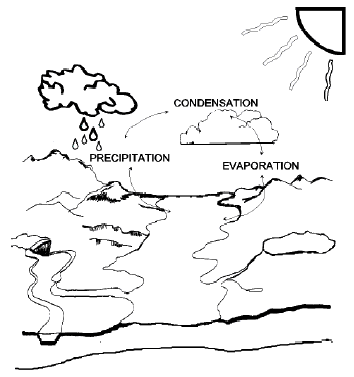BACKGROUND:
The hydrologic or water cycle is a
major driving force on our planet. Water is in constant motion, evaporating
into the atmosphere to and from oceans, lakes, rivers, and streams.
When the atmosphere can no longer support the moisture within the clouds
we experience rain, snow, hail, or sleet. Some water is locked
in the form of ice at the polar caps and in glaciers. Water is returned
to the system through drainage, which results from the melting of snow
that has accumulated during the winter months. This water flows on
the surface of the Earth and percolates through the Earth as groundwater.
Water is not actually consumed but is continuously recycled.
When water is heated, it changes from the liquid to the gas water
vapor. This process is called evaporation. When water vapor
is cooled, as it would be if it were taken higher in the atmosphere, this
gas will condense, or change back to liquid form.
We can see water vapor condensing when we
watch clouds. A cloud is nothing more than water vapor that has condensed
back to a liquid form. A cloud is made of extremely tiny drops of
water which can remain suspended in the air. A cloud is a colloid, or 2
states of matter (liquid and air). As a cloud grows, and more and
more water condense in the same place, the cloud droplets get larger.
Eventually, these cloud droplets will be too large to remain in the air.
The cloud is then said to be saturated. A saturated cloud will usually
precipitate its excess water, or cause it to fall. This is how it
rains or snows. Moisture falling from clouds is called precipitation.
The cycle of evaporation, condensation, and
precipitation of water is called the water or hydrologic cycle.
Since clouds move across the sky, the precipitation does not usually fall
in the same place that the water came from. This is how the Earth
spreads water across land areas and allows us to live in so many different
areas.
PROCEDURE:
- Using the enclosed diagram,
students should trace the movement of water through the water cycle as
well as find places where water can be stored and generated. Ask
students if they think that snow produces a lot of or a little of water.
They may be amazed that 10 inches of snow is required for 1 inch of rain.
- Have them notice that some water is
trapped under the Earth and then emerges as springs. In this diagram,
man-made features are illustrated to capture water, like reservoirs and
dams.
- Below is a diagram of the movements
that students should be able to trace. Slowly go over each of the
steps of the water cycle. See how much material they remember
from previous grades. Make sure the students understand each of the
vocabulary words.
